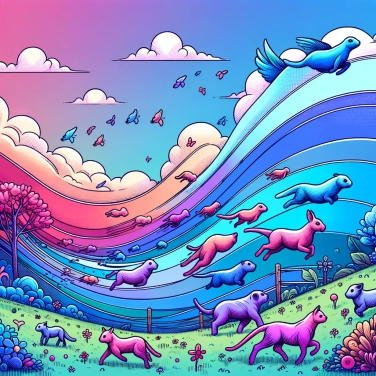The growth curves of animals are generally exponential because their growth often depends on the growth rate of their cells as well as the availability of nutrients, leading to a rapid increase in weight and size, characterized by exponential growth.

Animal growth is primarily a matter of cellular multiplication. Essentially, a young animal grows because its cells are rapidly dividing to create new ones. You start with a fertilized cell, then boom, one becomes two, two become four, and it’s off to a snowball effect. Each cell divides and increases the overall number of cells: this is what we call mitosis. At the same time, these cells also gradually increase in size: we simply call this cell growth. In the beginning, growth operates at full throttle because the available resources (nutrients, oxygen, energy) far exceed the needs. As a result, it grows quickly. This pace naturally leads to a rather exponential curve at first, as each stage produces more cells than the previous one. Of course, this doesn’t last forever, but these initial rapid stages of multiplication and expansion clearly explain the biological origin of this exponential progression.
Exponential growth comes from the ability of organisms to multiply. As long as there is enough food and the environment is favorable, each individual produces several offspring, who themselves become parents, and so on. Cells divide, doubling with each generation: one cell becomes two, the two become four, then eight, and then many, many more. This phenomenon of rapid and repeated cell division over a given period of time creates an exponential curve. The more individuals there are, the faster the growth accelerates. Obviously, it doesn't last forever: resources or space will eventually place a natural limit on this population explosion. It is said that growth then slows down to enter another, more stable phase.
The genes that the animal receives from its parents play a key role from birth: they largely determine its potential adult size, its growth rate, and even how it responds to nutritional inputs.
On the environmental side, the most influential factors are diet, access to water, and living conditions (temperature, available space). For example, a rich and balanced diet will stimulate rapid and exponential growth, while undernutrition or a stressful environment significantly hinders it.
Stress, indeed, is not to be overlooked: it slows weight gain by using energy to manage stress rather than for growth.
Finally, it is important to remember that certain molecules or hormones naturally present in the environment can directly influence physiological processes, either accelerating or limiting this famous exponential curve.
In animals with rapid reproduction, such as bacteria or certain insects, we often see a spectacular exponential growth. Take bacteria, for example: a single cell can give rise to two identical cells in just a few minutes, and those two in turn each produce two, then four, eight, sixteen… it escalates very quickly! The same goes for insects like flies or mosquitoes: a female can lay a vast number of eggs, leading to a rapidly growing population if nothing holds them back. Another cool example: some rodents, like mice, also have periods where their numbers explode at high speed, with each pair giving birth to several young at the same time, which quickly become adults and have their own offspring. This explosive growth continues until resources are depleted, a natural brake that brings all this wild activity back to a more reasonable pace.
In farming, understanding exponential growth simply allows for the optimization of resources. By knowing precisely when an animal has its growth peaks, we provide the right amount of food, not too little (which slows growth), and not too much (which wastes resources). This significantly helps to improve the economic yield of the farm. Specifically, we adjust the growth period to maximize the kilos of meat while limiting the time spent on feeding. The same idea applies to fish farmers: by well understanding exponential curves, they can decide the best time to harvest and reach the ideal commercial size in the shortest time. In short, managing farming through exponential curves aims for better profits, fewer losses, and a smart use of available resources.
In certain species of insects, exponential population growth can lead to impressive phenomena, such as swarms of migratory locusts that are capable of devouring or damaging entire agricultural crops in just a few days.
In certain animal species, such as fish, exponential growth can vary depending on the available space in their environment. Thus, fish in a restricted aquarium may sometimes grow more slowly than their counterparts in the wild.
Exponential growth is not infinite. In animals, it gradually slows down as the individual approaches adulthood, giving way to a sigmoidal growth curve (S-shaped).
Understanding exponential growth curves allows for the optimization of feed quantities in livestock farming: too little limits growth, while too much harms the economic efficiency of farming.
Sure! Here is the translation: "While the exponential curve theoretically has no limits and represents continuous and accelerated growth, the logistic curve starts with an exponential phase and then slows down to gradually reach a stable maximum, known as the environmental carrying capacity. This logistic model is more realistic and is commonly observed in nature."
No, usually exponential growth only lasts for a limited period. After an initial rapid phase, limiting factors, such as resource availability or internal biological constraints, slow down growth, which then takes on a more stable form resembling a sigmoid or logistic curve.
Genes largely determine an animal's growth potential by influencing various cellular and hormonal mechanisms. However, the full realization of this potential depends on both adequate living conditions (nutrition, available space, etc.) and specific environmental factors.
Understanding the patterns of exponential growth allows breeders to anticipate food needs, accurately predict the optimal stages for slaughter, and intervene when anomalies in growth occur, thereby ensuring better profitability and increased animal welfare.
Yes, some animal species develop a slower and more linear growth from birth. This is particularly true for animals with a long lifespan or those adapted to environments with limited resources, such as certain turtles or slow-metabolism reptiles.
Exponential growth refers to the phase where a population or organism grows in proportion to its current size. In animals, this is mainly observed during the early stages of physical development, where the available energy resources support rapid and continuous growth.

No one has answered this quiz yet, be the first!' :-)
Question 1/5